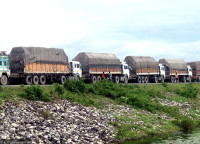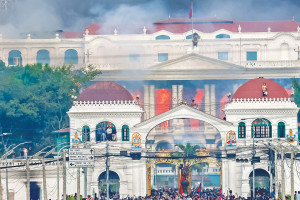Money
Dodhara Chandani dry port gets environmental approval
The Rs15 billion construction project in Kanchanpur district is listed as a national priority project by the government.
Krishana Prasain
The proposed Dodhara Chandani dry port and check post in far western Nepal has moved a step forward with the government’s approving the environmental impact assessment (EIA) report.
The Rs15 billion construction project is located in Dodhara Chandani Municipality, Kanchanpur district, and is listed as a national priority project by the government.
The construction site is spread over 250 bighas (189 hectares). On April 30, the cabinet cleared the use of 63 hectares inside Gaurishankar community forest, a buffer zone of Suklaphanta National Park, for the dry port.
According to the EIA, 15,057 trees need to be felled and; as per the Forest Clearance Guidelines, 10 compensatory trees must be planted for every tree cut for development projects. Project officials say that 150,525 compensatory trees need to be planted.
“The dry port will be built under an Indian grant. A memorandum of understanding will be signed soon between the two neighbours,” said Anish KC, a civil engineer at the Nepal Intermodal Transport Development Board. “Discussions are at an advanced stage,” he said.
Dodhara Chandani dry port will be the first business gateway to India from Nepal's far west. The site is 245 km from India’s capital New Delhi and 1,200 km from Gujarat state.
The dry port will facilitate trade with other Indian states like Rajasthan, Uttarakhand, Punjab and Haryana. It will provide access to India’s largest seaport, Jawaharlal Nehru Port in Mumbai, and facilitate Nepal's foreign trade and lower costs, officials said.
Dodhara Chandani inland container depot will contain administrative buildings, customs, banks, quarantine facilities, staff quarters, warehouses and parking space.
“As per our master plan, the project can accommodate 3,000 20-foot-long freight trucks,” said KC. “But in the first phase, the facility will be able to hold 300 trucks.”
The import warehouse will have an area of 7,000 square metres and the export warehouse will have an area of 2,520 square metres. There will be a railway warehouse spread over 17,500 square metres and a container stacking yard, a large open space to move containers, of 10,000 square metres.
The transshipment centre will be constructed in two phases, and the estimated cost of the first phase is Rs8 billion, according to the project. Dodhara Chandani dry port will be built on the border with India which will construct a twin dry port on its side of the border in Banbasa.
“The first phase will be linked by road while the second phase will be linked by rail,” KC said. “The completion deadline is three years from the start of construction.”
Work has already started on a Rs3.2 billion access road on the Indian side that will connect Dodhara Chandani. The access road is being built by the Indian government.
A four-lane bridge has been built over the Mahakali River, and work on an 8-km access road on the Nepal side—between Gadda Chauki and Malaria Nala at Dodhara Chandani-1—has reached the final stages.
The dry port will contribute to industrial development in the western region by boosting Indo-Nepal trade. Transporting goods to Nepal through these routes will result in substantial savings, according to Nepali officials.
Most of Nepal's trade infrastructure is concentrated in the country's east to connect with Kolkata port, and the construction of a dry port in Sudurpaschim province may facilitate access to more ports in India in the future.
The project is also expected to lower transportation costs and the time taken to import goods from India.
In March 2014, the Ministry of Industry, Commerce and Supplies conducted a feasibility study of Dodhara Chandani dry port.
The World Bank conducted a feasibility study for a dry port at Kanjabhoj in Dodhara Chandani Municipality a decade ago, and the Nepal Intermodal Transport Development Board prepared another report in 2016.
The second phase of the project will be spread over 126 hectares. Additional warehouses and parking areas will be built in the second phase.




 20.62°C Kathmandu
20.62°C Kathmandu














